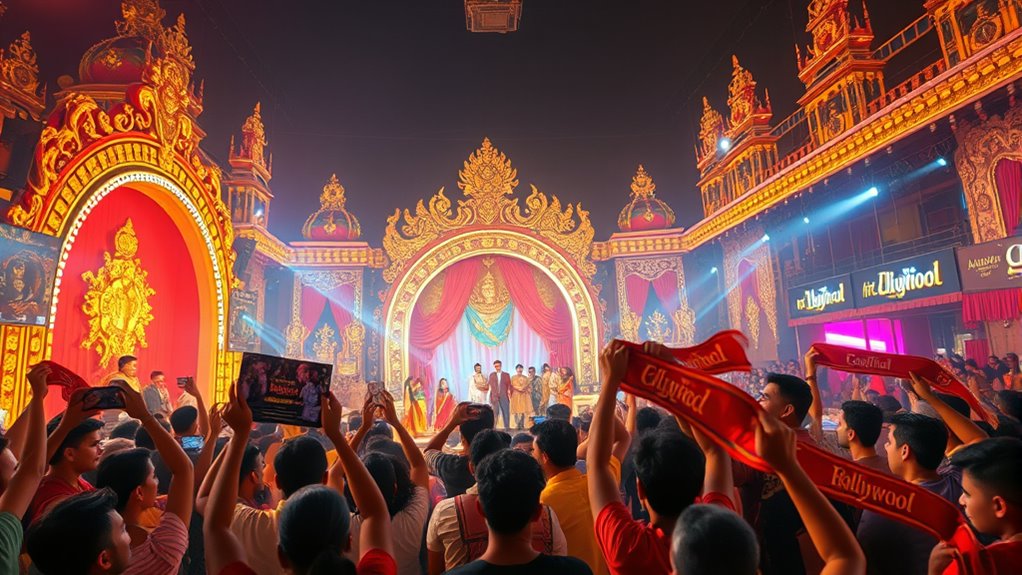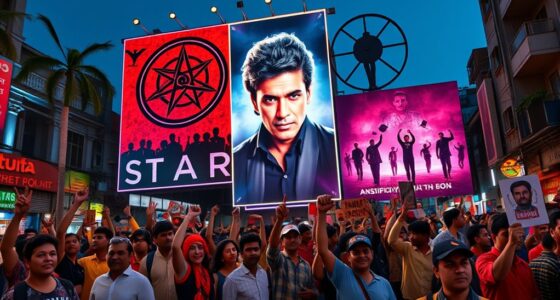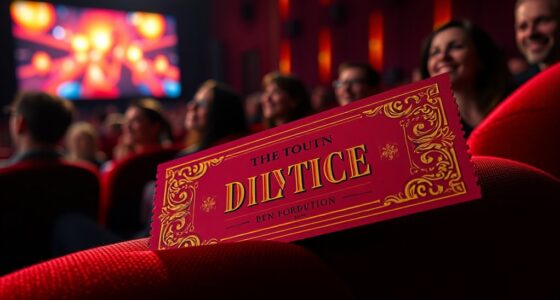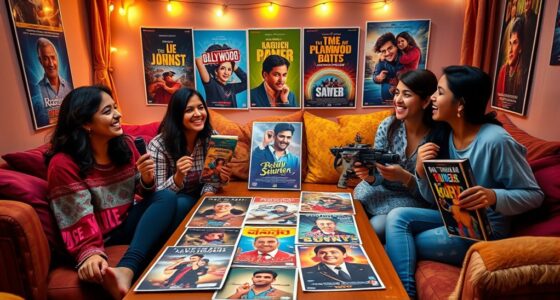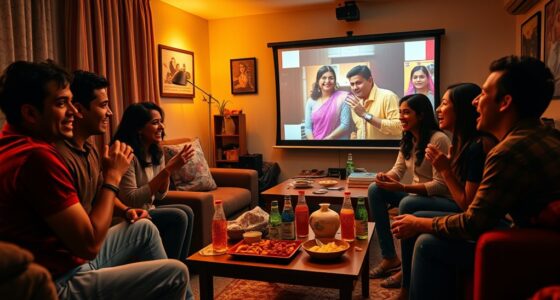Bollywood fan theories reveal shocking secrets behind your favorite films, from supernatural symbols and ghostly connections to hidden moral conflicts and emotional depth. You might not realize how SRK’s movies explore societal taboos, sacrifice, and love’s silent strength, all layered with complex plot twists and genre-bending stories. These theories uncover deeper meanings about characters, morality, and cultural reflections. If you keep exploring, you’ll discover even more mind-blowing insights hidden within Bollywood’s cinematic universe.
Key Takeaways
- Fans speculate SRK’s supernatural motifs symbolize deeper emotional and societal taboos, linking his films to metaphors of love and acceptance.
- Theories suggest SRK’s dual roles often represent internal psychological conflicts, blurring hero-villain boundaries and challenging traditional morality.
- Some fans interpret ghostly and mystical elements as clues to hidden plot secrets or alternate realities within Bollywood storytelling.
- Many believe SRK’s silent cues and nuanced expressions encode secret messages about love, sacrifice, and societal values.
- Fan theories propose that complex narratives and plot twists in SRK’s movies mirror real-life moral dilemmas and cultural taboos.
The Hidden Ghostly Connection in SRK’s Films
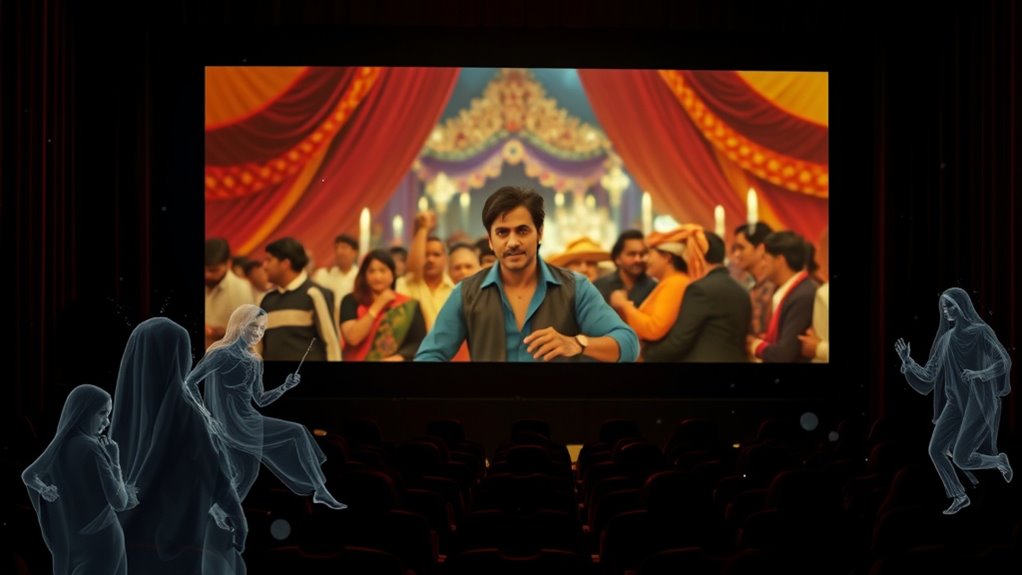
The hidden ghostly connection in SRK’s films reveals how supernatural elements are woven into storytelling to deepen emotional and thematic layers. In *Paheli*, a ghost impersonates SRK’s character Kishan after he leaves on a trip, creating a supernatural love story with Lachchi. This ghost isn’t just a spooky figure; it symbolizes unfulfilled desires, emotional needs, and societal taboos. The supernatural presence blurs the lines between reality and illusion, challenging traditional ideas of fidelity and identity. SRK’s films often use these ghostly motifs as metaphors, reflecting internal conflicts or cultural folklore. By integrating supernatural elements, SRK’s movies explore complex themes like love beyond physical boundaries, acceptance, and transformation, enriching the narrative with layers that resonate on emotional and cultural levels. In Paheli, the ghostly figure embodies the desire for companionship and the longing for love that defies societal constraints, further emphasizing the film’s exploration of personal freedom versus social expectations. Additionally, these supernatural themes serve to enhance storytelling depth by connecting viewers to universal human experiences through mystical symbolism. Moreover, incorporating supernatural elements allows filmmakers to creatively address societal taboos and cultural beliefs, making the stories more compelling and meaningful. Recognizing the influence of prophetic dreams in storytelling helps us understand how subconscious symbols can mirror cultural and emotional truths within films. This integration of supernatural motifs aligns with the broader Law of Attraction principles, where visualization and belief play key roles in shaping narrative outcomes and emotional resonance.
Sacrifice and Love: SRK’s Unseen Emotional Journeys
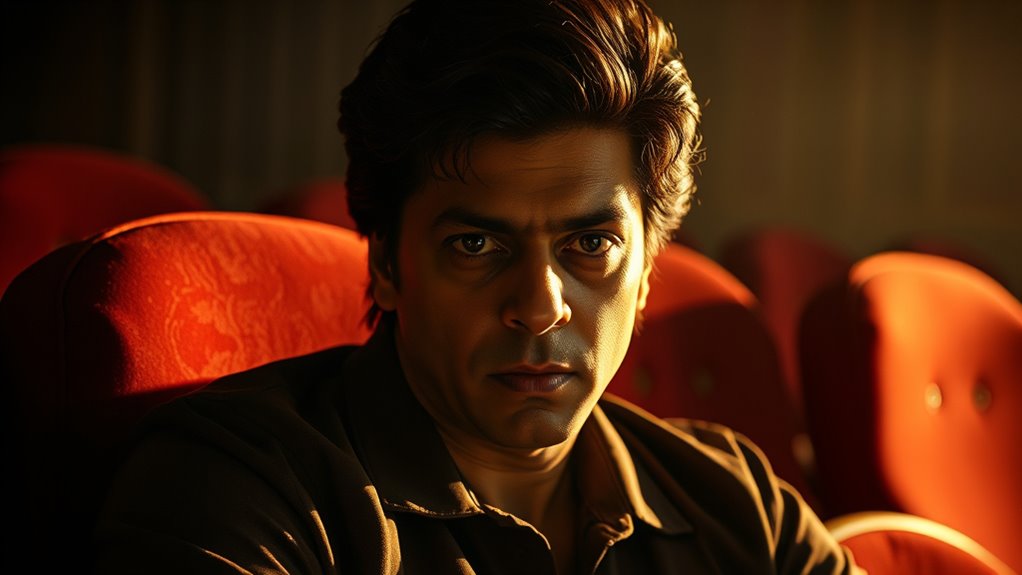
You might notice how SRK’s characters often make quiet sacrifices that go beyond the obvious, revealing unspoken depths of love. These hidden acts of selflessness shape their emotional journeys and deepen their connection with the audience. Exploring these subtle sacrifices can uncover powerful insights into the true nature of love in his films. For example, in “My Name Is Khan,” Rizwan Khan’s unwavering support for his family and his steadfast pursuit of acceptance demonstrate a profound sense of sacrifice that underscores his love and resilience. Such sacrifices are often portrayed with nuanced emotional depth, illustrating the emotional depth that characterizes Bollywood storytelling. Additionally, understanding the emotional connection between characters can enhance our appreciation of these sacrifices, revealing how love often requires quiet, unrecognized acts of kindness. Recognizing the cultural context behind these sacrifices can further enrich our understanding of their significance. Incorporating mindfulness techniques into viewing these films can help viewers appreciate the subtle emotional nuances and the depth of sacrifice portrayed in these stories. For instance, paying attention to non-verbal cues can reveal the unspoken emotions that deepen the viewer’s understanding of the characters’ inner worlds.
Hidden Sacrifices Revealed
Behind SRK’s iconic romantic roles lie powerful unseen sacrifices that deepen his characters’ emotional journeys. In *Veer-Zaara*, he endures heartbreak and separation, highlighting his willingness to sacrifice personal happiness for love’s enduring promise. In *Devdas*, he sacrifices his life, embodying tragic devotion that resonates deeply with audiences. His characters in *Kabhi Haan Kabhi Naa* and *Dilwale Dulhania Le Jayenge* demonstrate perseverance and personal loss, often risking social judgment. SRK’s portrayal of these sacrifices reveals an emotional depth that transforms simple love stories into profound tales of devotion. These hidden sacrifices aren’t just acting choices—they reflect cultural values of love, loyalty, and selflessness, making his characters’ journeys feel authentic and timeless, and forging an unbreakable connection with fans worldwide. Additionally, understanding the emotional complexity of SRK’s characters enhances appreciation for his dedication to portraying genuine love and sacrifice.
Unspoken Love Dynamics
Shah Rukh Khan’s ability to portray unspoken love elevates his characters beyond simple romance, revealing emotional depths that often go unnoticed. You notice how he uses subtle cues—lingering glances, restrained expressions, silence—to express feelings words can’t capture. His films, like *Kal Ho Naa Ho* and *Veer-Zaara*, showcase love’s quiet strength, where sacrifice and longing speak louder than dialogue. You see how internal conflicts are dramatized through music, cinematography, and nuanced acting, creating emotional realism. These unspoken moments reveal vulnerabilities, emphasizing that true love often resides in what’s left unsaid. SRK’s characters demonstrate that emotional honesty, sacrifice, and silent devotion define genuine romance, making his portrayals resonate deeply with audiences seeking authenticity in love stories. Additionally, his mastery of subtle cues helps convey complex emotional states without the need for explicit dialogue, enhancing the depth of his performances. Recognizing these unspoken love signals helps viewers appreciate the depth of his craft and the emotional intelligence he brings to his roles. Moreover, his ability to evoke emotional depth through subtle gestures makes his characters’ connections feel profoundly authentic. This nuanced acting approach underscores the importance of emotional honesty in creating memorable and impactful romantic stories. It also highlights how nonverbal communication plays a crucial role in expressing unspoken feelings on screen.
Teenage Romance and Its Complex Aftermath in Bollywood

Have Bollywood films truly captured the emotional rollercoaster that teenage romance often brings? Absolutely. These movies highlight innocence and first love, like in *Bobby* and *Rockford*, showing how pure emotions run deep. They also explore the complexities of teenage feelings—heartbreak, rivalry, and friendship—seen in *Jo Jeeta Wohi Sikandar* and *Mohabbatein*. Films set in school environments vividly depict the ups and downs of teenage life, including first crushes exemplified by ‘Pehla Nasha.’ The genre explores emotional depth, peer pressure, love, loss, and identity formation, resonating deeply with young audiences. Bollywood’s portrayal of teenage romance influences cultural perceptions of love, creating an emotional landscape that’s both relatable and aspirational, often leaving viewers reflecting on their own experiences. Bollywood’s portrayal of teenage romance reflects societal values and evolving cultural norms. Additionally, these films often incorporate themes of emotional development, which are crucial during adolescence and are portrayed through various narrative arcs. The depiction of peer relationships and social dynamics further emphasizes the importance of social acceptance during teenage years. These stories also highlight the significance of family support in shaping young people’s emotional resilience. Moreover, these stories often intersect with AI-driven storytelling techniques, enhancing emotional engagement and realism in modern cinema.
The Eternal Battle Between Chaos and Order in SRK’s Roles
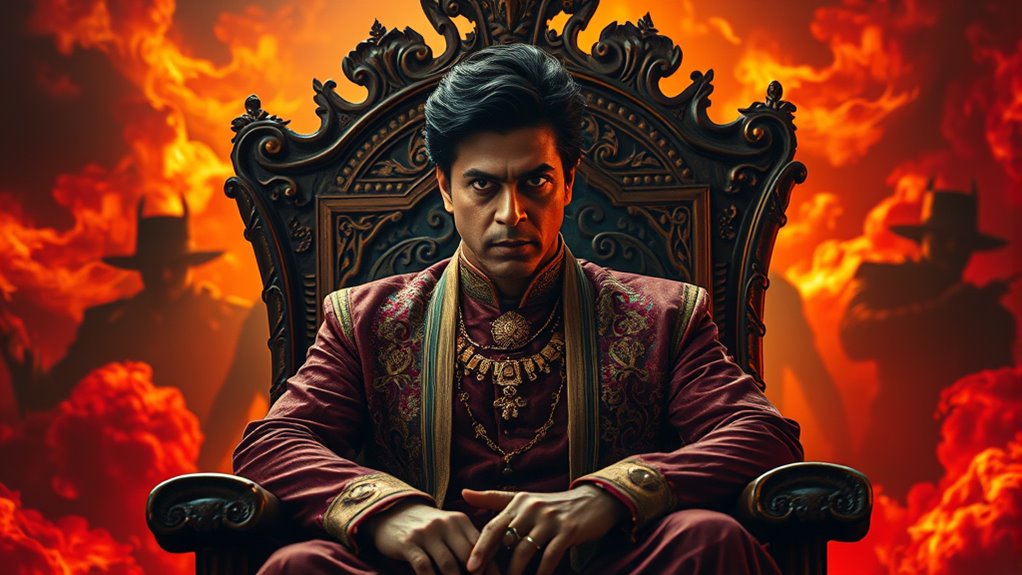
You notice how SRK often embodies both chaos and order in his roles, blurring the lines between hero and villain. His dual personalities symbolize the constant struggle between these forces, keeping audiences on edge. This balance influences how you perceive his characters, making his performances both complex and compelling. Moreover, this relationship dynamic reflects the importance of understanding the nuanced personalities that contribute to such compelling storytelling. Recognizing the internal conflict within his characters adds depth to his portrayals, highlighting how raw emotions can drive narrative tension. Additionally, the use of automation technologies in storytelling and production demonstrates how modern advancements can enhance creative processes and audience engagement.
SRK’s Dual Personalities
The dual roles played by SRK often embody an ongoing internal struggle between chaos and order, reflecting deeper psychological conflicts. You see this vividly in films like “Rab Ne Bana Di Jodi,” where Surinder symbolizes discipline and stability, while Raj embodies spontaneity and chaos. SRK expertly portrays these contrasting personas, highlighting an inner battle between control and impulsiveness. In “Fan,” he blurs the line between himself and an obsessive fan, illustrating the clash between authentic self and idealized identity. These roles reveal a recurring theme: characters grapple with moral dilemmas, self-acceptance, and redemption. By embodying these opposing forces, SRK not only entertains but also explores complex human psychology, making his dual characters resonate on a deeper level with audiences worldwide. Additionally, his ability to switch effortlessly between these personas showcases his versatility and mastery as an actor, further emphasizing the dual personality theme prevalent in his filmography. Understanding these contrasting aspects of his characters offers insight into asset division, where balancing different interests is key to achieving fairness and harmony. This nuanced portrayal invites viewers to reflect on the importance of internal balance and the ongoing psychological conflicts faced by individuals.
Symbolism of Chaos and Order
In SRK’s filmography, chaos and order often symbolize deeper psychological and moral battles, reflecting how you navigate life’s tumultuous aspects. In *Darr*, obsessive love disrupts stability, causing chaos that consumes the protagonist. *Baazigar* blurs lines between justice and chaos, showing how SRK’s character uses disorder to achieve his goals. *Anjaam* explores unrequited love, where obsession breeds destructive chaos. In *Koyla*, revenge fuels chaos, illustrating its destructive power. Conversely, films like *My Name Is Khan* highlight the pursuit of societal order amid chaos, emphasizing acceptance and harmony. Characters like Don and Raees operate within structured criminal worlds, embodying chaos but maintaining personal or societal order. These roles reveal how SRK’s characters embody the eternal struggle between chaos and order, shaping their moral and psychological landscapes.
Impact on Audience Perception
Have Shah Rukh Khan’s morally complex roles reshaped how audiences view the battle between chaos and order? Absolutely. His portrayals in *Raees* and anti-hero roles challenge traditional hero archetypes, sparking layered reactions. You find yourself drawn to his charismatic, flawed characters, making even the villain seem relatable. His nuanced performances blur the lines between good and evil, prompting viewers to see morality as more gray than black and white. Audience engagement is further influenced by his consistent casting in leading roles, which set clear expectations. The commercial success of films like *Pathaan* reinforces these perceptions, while mixed reviews deepen discussions. Overall, SRK’s roles encourage fans to rethink chaos and order, recognizing the complexity behind every morally ambiguous character.
Multi-Layered Plot Twists and Social Commentary

Bollywood filmmakers skillfully embed multi-layered plot twists to challenge your expectations and deepen the storytelling. Take *Kahaani* (2012): the protagonist’s false pregnancy reveals a clever revenge plot intertwined with social themes of identity and deception. In *Andhadhun* (2018), a blind pianist’s true nature exposes societal perceptions of ability and normalcy, blending dark comedy with thriller elements. *Drishyam* (2015) features a family’s smart cover-up, highlighting justice and media influence. *Talaash* (2012) uses a supernatural twist to explore guilt and redemption, while *Ugly* (2013) weaves multiple twists around societal issues like class inequality and exploitation. These layered twists not only surprise you but also serve as social commentaries, prompting reflection on deeper societal issues behind the entertainment.
The Duality of Characters: Moral Conflicts in Recent Releases

You’re often drawn to characters facing inner moral dilemmas that reveal unexpected layers. These conflicts blur ethical boundaries with emotional choices, making their journeys more compelling. By exploring these dualities, filmmakers challenge you to reconsider notions of right and wrong in complex situations.
Inner Moral Dilemmas
- Social issues challenge characters’ morals, forcing tough choices
- Cultural expectations often conflict with personal beliefs
- Personal growth emerges through maneuvering moral conflicts
Hidden Character Layers
Recent Bollywood films are increasingly exploring the complexity of their characters by revealing hidden layers and dualities that deepen the narrative. You’ll notice characters with dual roles or conflicting traits that add richness and intrigue. These layers often highlight moral conflicts, showing characters grappling with contrasting ideals, which creates internal tension. Films also explore psychological struggles, revealing inner transformations that make characters more relatable. Dual roles are used not just for plot twists but as a mirror of societal divides or internal dilemmas. This approach enhances storytelling by adding mystery and depth, engaging viewers on a deeper level. As you watch, you’ll see how these hidden layers challenge perceptions and invite reflection on morality, making the stories more compelling and thought-provoking.
Ethical vs. Emotional
Have you ever wondered how Bollywood characters grapple with moral dilemmas that pit their ethical beliefs against their emotional impulses? In recent films, this duality heightens drama and sparks debate. You’ll notice characters:
- Facing conflicts between traditional values and modern ethics, like in PKand *Fire*, which reflect societal debates.
- ___social norms___, where personal desires clash with societal expectations, creating tension.
- Encountering plot twists that challenge moral expectations, like in Khakeeand *Being Cyrus*, adding narrative depth.
These conflicts often force characters to choose between doing what’s right and what feels emotionally right, making their struggles relatable. Emotional responses influence their decisions, affecting audience engagement and prompting viewers to reflect on their own moral boundaries.
SRK’s Soldier in “Jawan”: A Tale of Sacrifice and Morality

What makes SRK’s portrayal of Vikram Rathore in “Jawan” so compelling is how his character embodies the complex dance between sacrifice and morality. You see, Rathore’s dual identity as Azad, a jailer and hijacker, highlights his willingness to operate outside the law for social justice. His actions, like hijacking a train to help impoverished farmers, aren’t random—they’re calculated sacrifices to fight corruption. Below is a glimpse of his multifaceted role:
| Identity | Role | Moral Dilemma |
|---|---|---|
| Azad | Jailor | Balances duty and rebellion |
| Vikram Rathore | Vigilante | Acts for social justice |
| Leader of inmates | Empowerment | Challenges authority |
| Hero’s arc | Sacrifice | Personal vs. larger good |
This layered persona captures the essence of a hero torn between duty and morality.
Genre-Bending and the Interpretive Nature of Bollywood Films

Bollywood’s storytelling style has evolved far beyond straightforward plots, embracing a rich tapestry of hybrid genres that challenge traditional boundaries. You now see films blending elements like action, comedy, romance, and social issues, creating layered narratives. This genre-bending allows you to interpret films in multiple ways, depending on your perspective. For example:
- Films like Queenand *Raazi* combine traditional storytelling with modern themes, reflecting cultural shifts.
- Masala films mix genres such as action, comedy, and musical, keeping audiences engaged with diverse entertainment.
- The influence of globalization and technology has encouraged filmmakers to experiment, resulting in innovative hybrid genres that appeal worldwide.
This evolution promotes individualism and self-empowerment, making Bollywood films more dynamic and open to interpretation.

Many Bollywood films explore the psychological depths of their characters, revealing hidden motives and emotional traumas that shape their actions. In movies like *Dil Chahta Hai*, Freud’s theory helps you see Akash as driven by the id, while Sameer balances impulses with moral judgment as the ego, and Sid embodies moral ideals as the superego. Similarly, *Dor* shows how characters like Meera and Zeenat navigate desires and moral constraints, illustrating these psychological dynamics. Films also portray mental health issues, often focusing on women, which can influence public perception and stigma. Traumatic events, like betrayal or loss, trigger shifts in behavior and identity, deepening character complexity. These insights reveal how Bollywood uses psychology to craft emotionally charged narratives that resonate on a profound level.
Cinema as a Mirror: Societal Norms and Cultural Critiques
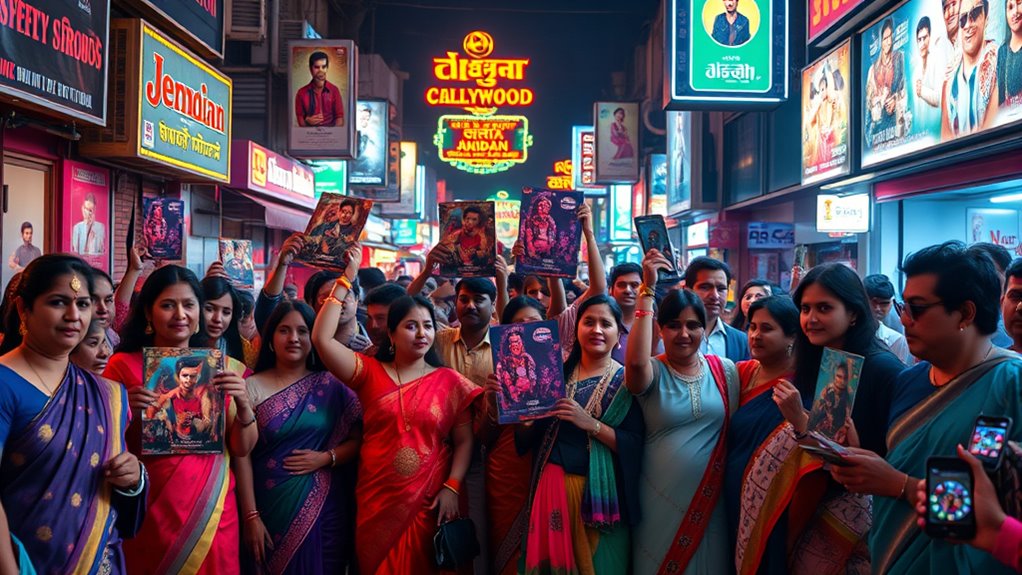
Cinema serves as a powerful mirror to Indian society, reflecting its traditions, social norms, and cultural values. You see this in Bollywood’s portrayal of weddings with ethnic attire and music, which helps preserve Indian customs. Films also depict social rituals and festivals, creating a shared cultural space for audiences to connect with their heritage. Many storylines emphasize family bonds and collective values, reinforcing societal expectations. Additionally, Bollywood often showcases religious observances, embedding cultural specificity into mainstream narratives for both local and diaspora viewers. This cinematic approach transmits and sustains cultural identity amid globalization pressures.
- Celebrates traditional ceremonies and festivals, reinforcing cultural pride
- Highlights familial and societal expectations within narratives
- Balances modernity with traditionalism, reflecting societal shifts
Frequently Asked Questions
How Do Fan Theories Influence Bollywood Film Marketing Strategies?
Fan theories shape Bollywood marketing strategies by boosting pre-release buzz. You create and share content on social media, which increases visibility and engagement. Studios monitor trending theories to tailor campaigns, allocate digital budgets, and collaborate with influencers. Your active participation fosters anticipation, making you more likely to watch the film. As a result, fan theories drive excitement, loyalty, and long-term engagement, ultimately boosting box office performance and franchise growth.
What Role Do Supernatural Elements Play in Bollywood Social Commentary?
Supernatural elements in Bollywood serve as powerful tools for social commentary. You’ll see them blend fantasy and reality to highlight societal issues like gender discrimination, patriarchy, and mental health. These themes often use spirits or magical realism to symbolize fears and injustices, making tough conversations more relatable and engaging. By doing so, filmmakers challenge traditional norms and encourage you to rethink societal beliefs through compelling supernatural narratives.
Are Srk’S Characters Intentionally Designed With Hidden Psychological Motives?
Did you know that over 80% of SRK’s characters display psychological depth? His roles are intentionally crafted with hidden motives, reflecting real struggles like identity, social issues, and emotional resilience. You’ll notice his performances reveal complex psychological layers, engaging your mind and emotions. By doing so, he connects on a deeper level, making his characters more relatable and impactful, encouraging viewers like you to explore the underlying motives behind each role.
How Do Bollywood Films Depict the Conflict Between Societal Norms and Personal Desires?
You see Bollywood films often depict a struggle between societal norms and personal desires, highlighting characters torn between family obligations and individual happiness. They show how tradition enforces gender roles and social expectations, making personal choices risky. Films portray characters resisting these norms—falling in love outside accepted boundaries or seeking independence—while facing social backlash. This tension creates emotional storytelling that explores the cost of challenging societal conventions.
Can Fan Interpretations Alter the Perceived Moral Messages of Bollywood Movies?
You might wonder if fan interpretations can change how you see the moral messages in Bollywood movies. The answer is yes; when fans share their views, they shape perceptions and even challenge the intended morals. Social media amplifies these ideas, allowing you to see different perspectives. Your own background and cultural norms influence how you interpret these messages, making fan theories powerful in shaping your understanding of a film’s moral core.
Conclusion
As you explore these mind-blowing fan theories, you’ll realize Bollywood films are more than just entertainment—they’re intricate reflections of society and human emotion. Imagine uncovering a secret ghostly connection in SRK’s movies, revealing hidden truths about love and sacrifice. Next time you watch, look beyond the surface, and you might just see the deeper stories waiting to be uncovered, transforming your viewing experience into a mesmerizing journey of discovery.
